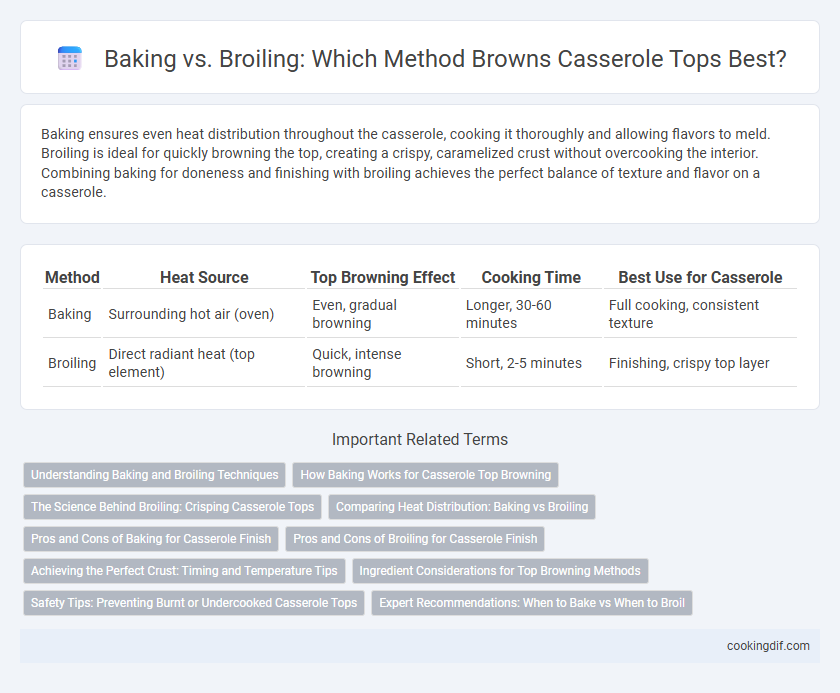Baking ensures even heat distribution throughout the casserole, cooking it thoroughly and allowing flavors to meld. Broiling is ideal for quickly browning the top, creating a crispy, caramelized crust without overcooking the interior. Combining baking for doneness and finishing with broiling achieves the perfect balance of texture and flavor on a casserole.
Table of Comparison
| Method | Heat Source | Top Browning Effect | Cooking Time | Best Use for Casserole |
|---|---|---|---|---|
| Baking | Surrounding hot air (oven) | Even, gradual browning | Longer, 30-60 minutes | Full cooking, consistent texture |
| Broiling | Direct radiant heat (top element) | Quick, intense browning | Short, 2-5 minutes | Finishing, crispy top layer |
Understanding Baking and Broiling Techniques
Baking a casserole ensures even heat distribution, cooking the dish thoroughly while allowing the top to brown gradually without burning. Broiling applies intense direct heat from above, ideal for quickly achieving a crispy, golden crust but requiring close monitoring to prevent charring. Mastering the balance between baking for thoroughness and broiling for surface browning enhances both texture and flavor in casseroles.
How Baking Works for Casserole Top Browning
Baking browns a casserole top primarily through dry heat surrounding the dish, promoting even Maillard reaction and caramelization on the surface. The moderate, consistent oven temperature allows moisture to evaporate gradually, creating a golden crust without burning. This method ensures thorough cooking and balanced browning throughout the casserole topping.
The Science Behind Broiling: Crisping Casserole Tops
Broiling uses intense, direct radiant heat from above, rapidly caramelizing sugars and proteins on the casserole surface to create a crisp, golden-brown crust. This high-temperature exposure induces the Maillard reaction, enhancing flavor complexity and texture contrast. Baking, by contrast, applies gentler, ambient heat, which cooks evenly but lacks the concentrated top heat required for optimal browning and crispness.
Comparing Heat Distribution: Baking vs Broiling
Baking provides even heat distribution throughout the entire casserole, allowing the dish to cook uniformly from the inside out while gently browning the top. Broiling directs intense, high-heat from above, quickly browning and crisping the casserole's surface but risks uneven cooking or burning if not closely monitored. For optimal top browning with balanced internal cooking, baking is preferred, whereas broiling is ideal for a rapid, intense finish on the casserole's crust.
Pros and Cons of Baking for Casserole Finish
Baking a casserole ensures even heat distribution, allowing flavors to meld and the dish to cook thoroughly from top to bottom. This method creates a consistent texture but may not achieve the intense, crispy browning on the top that broiling offers. Baking is ideal for casseroles requiring slow cooking and moisture retention, though it may lack the quick, golden crust characteristic of broiled finishes.
Pros and Cons of Broiling for Casserole Finish
Broiling for casserole top browning offers intense, direct heat that quickly crisps and caramelizes the surface, enhancing texture and visual appeal. However, the rapid heating increases the risk of uneven browning or burning if not closely monitored, requiring careful timing and attention. Unlike baking, broiling does not uniformly cook the entire casserole, so it is best used strictly as a finishing technique rather than the primary cooking method.
Achieving the Perfect Crust: Timing and Temperature Tips
Baking a casserole at 350-375degF for the majority of cooking ensures even heat distribution and thorough cooking, while broiling at high temperatures (500-550degF) for the last 2-5 minutes rapidly browns the top for a crispy, golden crust. Timing the broil carefully prevents burning and achieves the ideal balance between a creamy interior and a perfectly browned top. Optimal crust formation relies on monitoring temperature and using broil function strategically after the casserole is fully baked.
Ingredient Considerations for Top Browning Methods
Baking provides even heat that gently melts cheese and crisps toppings without burning, ideal for casseroles with delicate ingredients like cream-based sauces or vegetables. Broiling exposes the casserole top to intense, direct heat, quickly browning cheese or breadcrumbs but risks scorching if ingredients are moisture-rich or heat-sensitive. To achieve optimal browning, choose baking for casseroles with high moisture content and broiling for drier toppings such as grated hard cheeses or panko crumbs.
Safety Tips: Preventing Burnt or Undercooked Casserole Tops
Baking ensures even heat distribution for thorough cooking and safer browning of casserole tops, reducing the risk of undercooked interiors. Broiling provides intense, direct heat that can quickly brown the surface but requires close monitoring to prevent burnt spots or flare-ups. Using oven mitts, positioning the rack properly, and checking the casserole frequently are key safety tips to achieve a perfectly browned top without compromising texture or taste.
Expert Recommendations: When to Bake vs When to Broil
Experts recommend baking casseroles at moderate temperatures (350degF to 375degF) for thorough cooking and even heat distribution, ensuring the fillings are fully cooked and flavors melded. Broiling is advised only at the end of cooking to quickly brown and crisp the casserole top, enhancing texture without drying out the interior. Prolonged broiling risks uneven heating and burning, so it's best reserved for final minutes under close supervision.
Baking vs Broiling for casserole top browning Infographic

 cookingdif.com
cookingdif.com